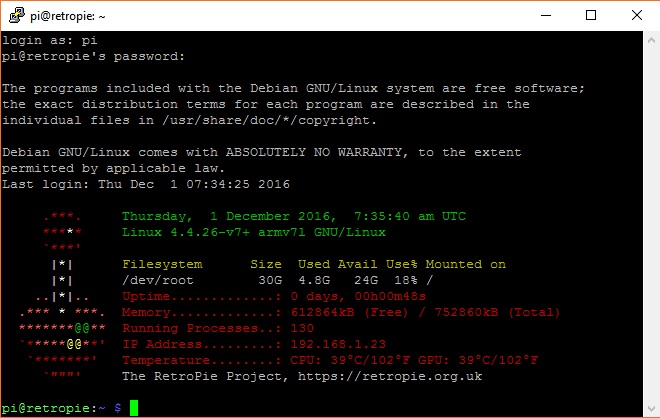
- EDIT TEXT FILE IN TERMINAL RASPBERRY PI INSTALL
- EDIT TEXT FILE IN TERMINAL RASPBERRY PI UPDATE
- EDIT TEXT FILE IN TERMINAL RASPBERRY PI UPGRADE
- EDIT TEXT FILE IN TERMINAL RASPBERRY PI CODE
EDIT TEXT FILE IN TERMINAL RASPBERRY PI UPGRADE
Or we can upgrade all of the software on our Raspberry Pi.
EDIT TEXT FILE IN TERMINAL RASPBERRY PI INSTALL
Then we can install a specific application, for example to install vlc.
EDIT TEXT FILE IN TERMINAL RASPBERRY PI UPDATE
To use apt we will need to use sudo as it will make changes to the operating system.įirst we update the list of installable software. apt - Install and manage softwareĪpt, the Advanced Packaging Tool. Just like any computer we need to make sure that our software is up to date and on our Raspberry Pi the tool to do just that is called apt. For example let's create a directory called Work in our home directory. To copy a directory, for example /home/pi/ test2 to /home/pi/Documents/ we need to use the -r option to copy everything across.Ĭp -r test2/ Documents/ mkdir - Create a directoryĬreate a new directory to store work. To copy a file, for example test.py to our Documents directory. In this example we delete the file test.py. With this command we can delete files and directories. The command can also be used to rename a file or directory. For example here we move test.py to the Documents directory. We can move a file from one location to another. From the terminal we can do that and much more.

Moving, deleting, copying and creating new files and directories are some of the most basic actions that we need to do. Useful for closing non responsive applications. Shows the current CPU load, RAM usage and running system processes.

Here we show a few commands to get you started. Managing our operating system and checking system resources is standard practice in the terminal. Inside nano we navigate using the arrow keys and it works just like a regular text editor. Įdit an existing file, for example test.py. Nano is the easiest command-line editor for beginners.Ĭreate a new file, for example newfile.txt.
EDIT TEXT FILE IN TERMINAL RASPBERRY PI CODE
In this example we use lscpu to print the details of the CPU which is passed via a pipe | to grep which we instruct to look for “MHz”.įor when you quickly need to edit a config file, Python code or just write a to do list. Typically used with log files when looking for issues. To search inside a file for a specific word / section of text. Less /var/log/syslog grep - Looking inside a file This command will print the contents of a file in sections and we can scroll through the file using the arrow keys, Page Up / Down and Home / End. Print contents of the file to the terminal with line numbers. Print the contents of a file to the terminal, for example a Python file. Sometimes we need to take a peek inside a file, look for a specific command, error or bug and with these commands we can do just that all from the terminal. Go back to the previous directory that we were in. Move to a directory in another part of the filesystem, for example /var/log. For example to move from our home directory to Downloads Using this command we can move around the filesystem.

List all files of a certain type, for example. See hidden files and directories, in a long list with extra details. List the files in another directory, such as /var/log: This command is used to list the contents of a directory. To use "sudo," you will have to be in the "subdoers" permission group, but the good news is that the default Raspberry Pi user is already in this group.įor example, to upgrade your operating system, you'd type: However, by prefacing any command with the word "sudo," you can have admin rights for that execution. sudo - Super User Doīy default, Raspbian, like all forms of Linux doesn't give you the admin privileges you need to perform some core tasks like installing software. So let's start our adventure by testing out a few commands and learning more about home our Raspberry Pi works. In this guide we shall cover this and much more. To make system wide changes we either need to be a user called “root” which has similar powers to administrator on Windows, or we need to use sudo (see below) to temporarily give us extra permissions.

But we cannot harm the underlying filesystem as we do not have permission to do so. In our home directory we can store our work, projects, pictures etc.


 0 kommentar(er)
0 kommentar(er)
